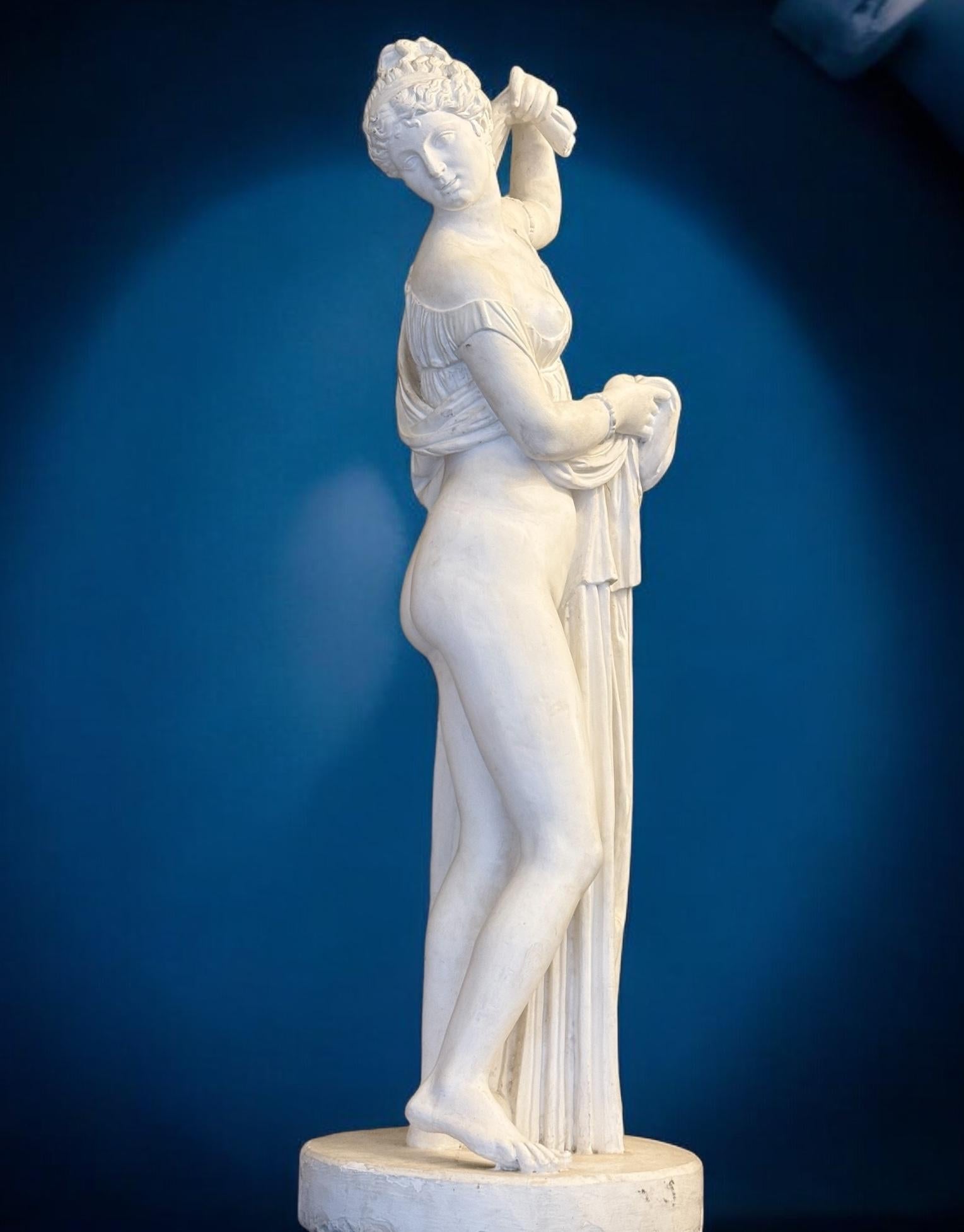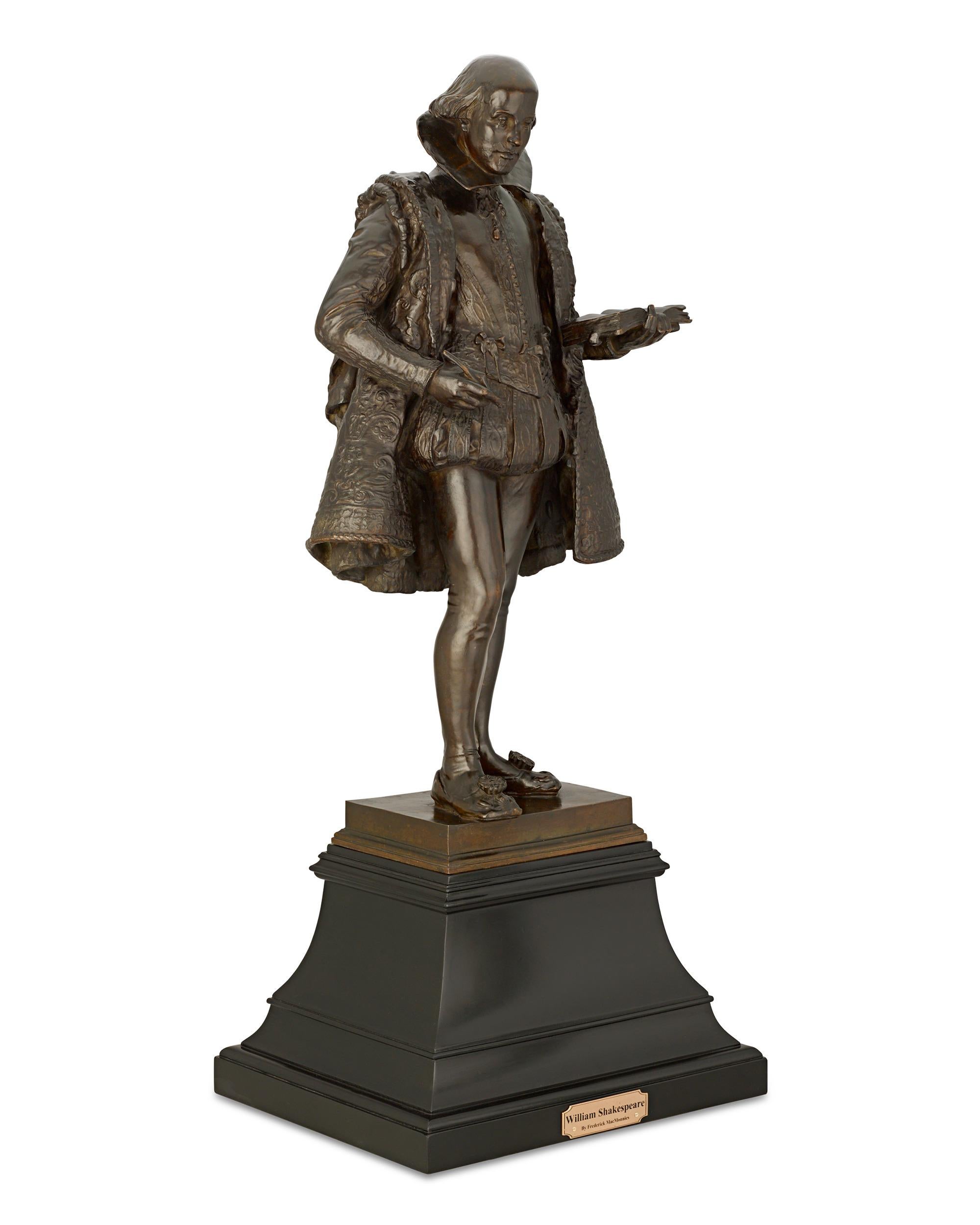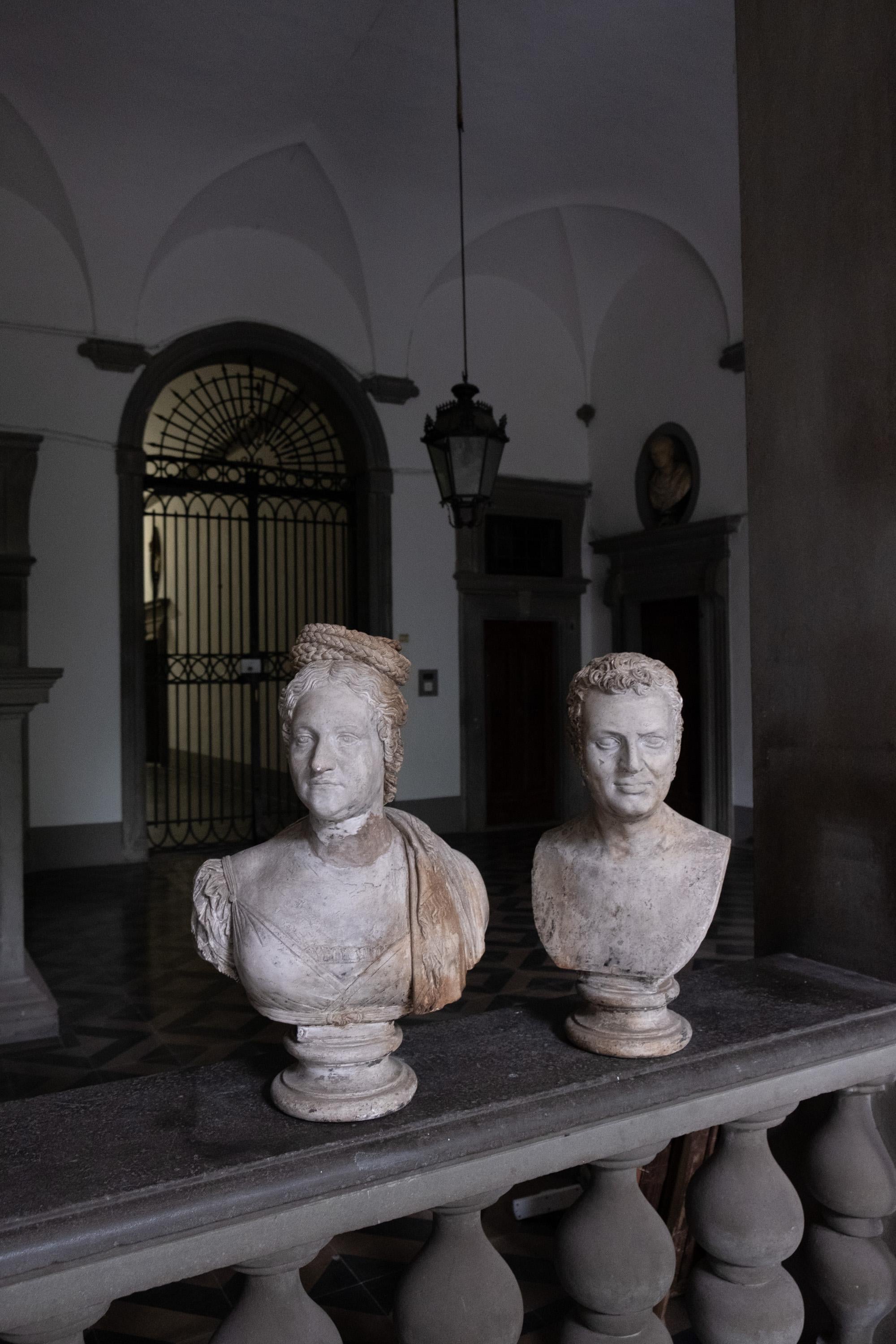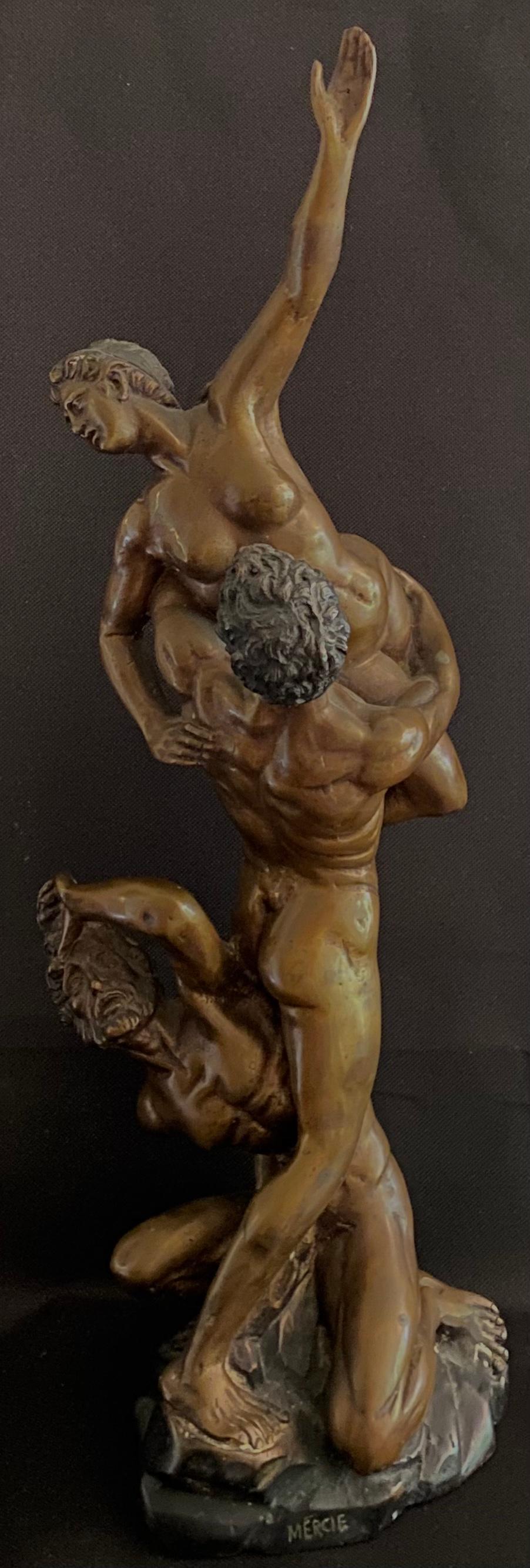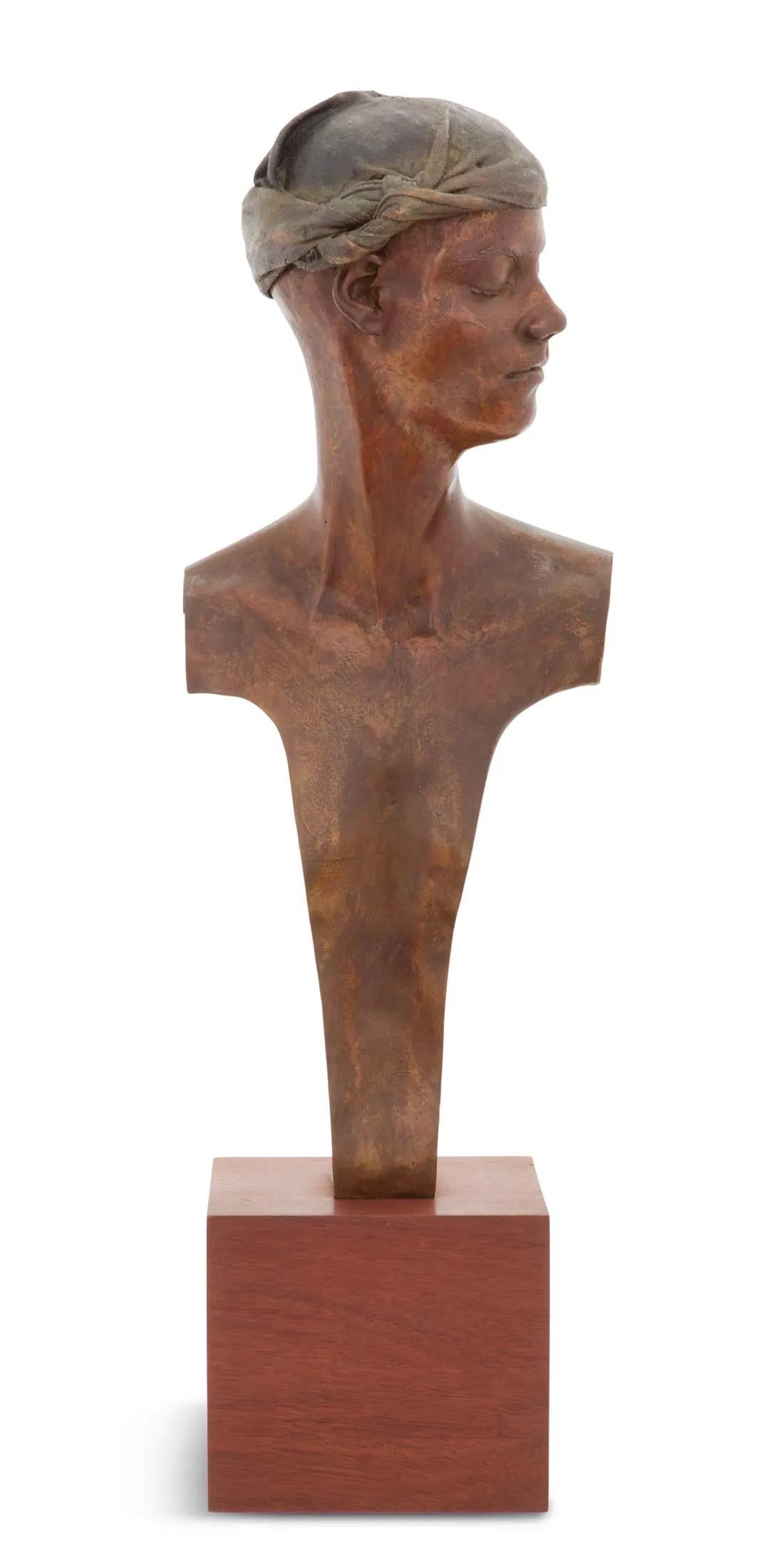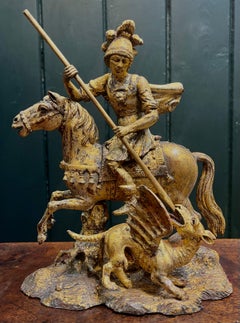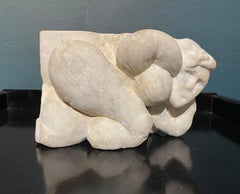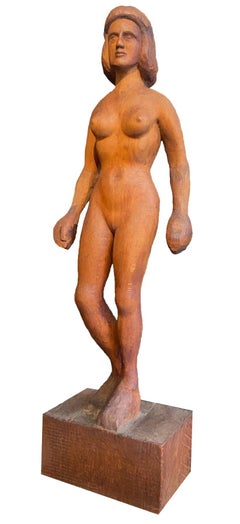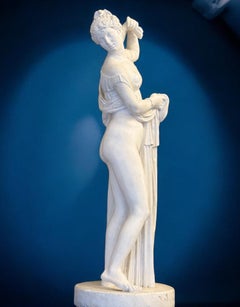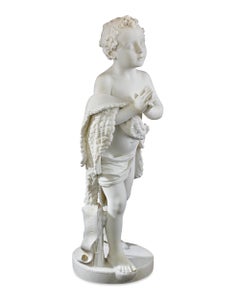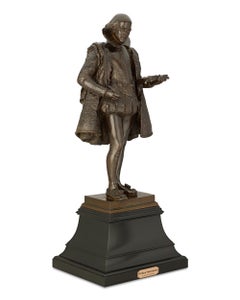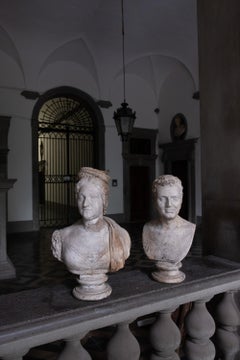Items Similar to Wolfgang Amadeus Mozart, 18th Century Half Length Sculpture
Want more images or videos?
Request additional images or videos from the seller
1 of 5
19th Century European SchoolWolfgang Amadeus Mozart, 18th Century Half Length Sculpture
About the Item
Plaster, raised pins and later coloured to simulate terracotta
Height: 32 3⁄4 inches (83.5 cm).
Full of elegance and liveliness, it conveys the consummate ability of the artist. Beautifully reinterpreting the portrait conventions inherited from eighteenth-century sculpture, Mozart is presented in a three-quarter view, his gaze turned. His wonderfully elaborate hair and the sweeping drapery reminds the viewer of the swagger of the previous century, as does the well-rendered folio and quill, giving the sitter a sensuous sophistication and conferring a sense of majesty appropriate of Mozart.
An exceptional, fine quality, mid-nineteenth century work, it bears nail heads and markings that apparently served as precise reference points for the sculptor. The nails are placed similar distances apart to determine the exact depth and spacing the sculptor needs to chisel.
Nails are visual tools that help sculptors achieve the correct dimensions for the sculpture.For sculptors to get accurate pointing on their sculptures and depict their subjects realistically, many points have to be used. This is especially true for complicated sculptures, like life-sized sculptures of people.
If a sculptor were to just start on a stone block first and mess up, they would need to start from scratch. The block of stone would potentially be wasted.
Once a plaster sculpture is completed, the dimensions are transferred from the plaster sculpture to the stone block with the pointing tool. The nail on the pointing tool is used as the pointer to get the reference distance so that depth is transferred correctly.
The pointing tool was perfected by the famous Italian sculptor Antonio Canova in the 1700s and used a nail as its main measurement mechanism.
Plaster sculptures save sculptors from destroying valuable stone sculpting material like marble.
- Creator:19th Century European School
- Dimensions:Height: 32 in (81.28 cm)Width: 15 in (38.1 cm)
- Medium:
- Movement & Style:
- Period:
- Condition:
- Gallery Location:London, GB
- Reference Number:1stDibs: LU52411937942
About the Seller
5.0
Vetted Professional Seller
Every seller passes strict standards for authenticity and reliability
Established in 2007
1stDibs seller since 2014
80 sales on 1stDibs
Typical response time: 3 hours
- ShippingRetrieving quote...Shipping from: London, United Kingdom
- Return Policy
Authenticity Guarantee
In the unlikely event there’s an issue with an item’s authenticity, contact us within 1 year for a full refund. DetailsMoney-Back Guarantee
If your item is not as described, is damaged in transit, or does not arrive, contact us within 7 days for a full refund. Details24-Hour Cancellation
You have a 24-hour grace period in which to reconsider your purchase, with no questions asked.Vetted Professional Sellers
Our world-class sellers must adhere to strict standards for service and quality, maintaining the integrity of our listings.Price-Match Guarantee
If you find that a seller listed the same item for a lower price elsewhere, we’ll match it.Trusted Global Delivery
Our best-in-class carrier network provides specialized shipping options worldwide, including custom delivery.More From This Seller
View AllSt George Slaying the Dragon
Located in London, GB
18th Century European School
St George Slaying the Dragon
Wood, gilded
8 inches in height, 6 3/4 x 4 inches base
This 18th century carved and gilt wood statuette depicts the moment ...
Category
18th Century Figurative Sculptures
Materials
Wood
Lambeth Plate, English Delftware, Blue and White Design c. 1750
Located in London, GB
English Delftware blue and white plate, painted with a flower and bird design
Diameter: 8 3/4 inches (22.25 cm)
Delftware is also known as Delft Blue, was originally a general term ...
Category
1750s Sculptures
Materials
Ceramic, Delft
Reclining Figure Carved Marble Early 20th Century France
Located in London, GB
Circle of Henri-Gaudier-Breska
1891-1915
Reclining Figure
Carved marble
Height 5 inches
Born Henri Alphonse Séraphin Marie Gaudier near Orléans in France, Gaudier-Brzeska started using his hyphenated name in 1910 when he met the Polish writer Sophie Brzeska. They moved to London together in January 1911 and adopted their new names and the identity of brother and sister in order to make their cohabitation respectable.
Gaudier-Brzeska started to establish himself as a sculptor in 1912. Initially influenced heavily by Rodin, he later assimilated more influences from the modernist movement of cubism and from examples of non-European art he saw in London’s museums. He met the sculptor Jacob Epstein in June 1912, who further encouraged him to break with classical Greek tradition.
While working from 25 Winthorpe Road in 1913–14, Gaudier-Brzeska became increasingly involved in London’s avant-garde art scene. He exhibited at the London Salon in July 1913, where he met the poet and arts patron Ezra Pound. Pound described Brzeska as ‘like a well-made young wolf or some soft-moving, bright-eyed wild thing’. Gaudier-Brzeska subsequently became associated with the vorticist movement led by Wyndham Lewis, contributing two important articles to Lewis’s magazine Blast and signing his name against the vorticist manifesto.
He was also a founding member of the London Group, which formed when the all-male Camden Arts Group joined with independent artists to challenge the dominance of the Royal Academy of Arts. Other founding members included Walter Sickert, Robert Bevan and Spencer Gore...
Category
Early 20th Century Figurative Sculptures
Materials
Marble
Nude Statue, 20th Century Carved Oak
Located in London, GB
Carved Oak, 20th Century European School Nude Statue
Height: 21 3/4 inches
Category
20th Century Modern Figurative Sculptures
Materials
Oak
Bronze Head of a Young Boy, Early 20th Century English Sculpture
Located in London, GB
English School
Early 20th Century
Head of a Young Boy
Bronze with stone base
Height: 12 3/4 inches (32.5 cm)
Category
Early 20th Century Figurative Sculptures
Materials
Stone, Bronze
Head of Dame Edith Sitwell
Located in London, GB
Maurice Lambert
Head of Dame Edith Sitwell
1901-1964
Patinated bronze on marble base
Dimensions: 7 x 16 inches (18 x 41 cm)
Provenance
Private collection
Originally commissioned by Edith's brother Osbert Sitwell circa 1926/27. Our version is of the same period and must have been commissioned at the same time. A version of this piece made in 1984 in aluminium is held in the permanent collection of the National Portrait Gallery (NPG 5801).
Maurice Lambert
Maurice Lambert, born in Paris, was son of the Russian-born Australian painter George Washington Lambert...
Category
20th Century Modern Figurative Sculptures
Materials
Marble, Bronze
You May Also Like
Life-size Plaster Statue of The Callipygian Venus or Aphrodite 1920'
Located in Rome, IT
Italian life-size plaster sculpture , figure of the Callipygian Venus, after the antique Roman marble statue.
Aphrodite Kallipygos, or Callipygian Venus literally means “Venus of ...
Category
1920s Academic Nude Sculptures
Materials
Plaster
$8,260 Sale Price
20% Off
Young St. John the Baptist by Domenico Menconi
Located in New Orleans, LA
Masterfully carved with remarkable detail, a youthful Saint John the Baptist folds his hands in prayer in this stunning marble by the important Italian sculptor Domenico Menconi. The...
Category
19th Century Academic Figurative Sculptures
Materials
Marble
Patinated Bronze Statuette of William Shakespeare
By Frederick William MacMonnies
Located in New Orleans, LA
Frederick William MacMonnies
1863–1937 American
William Shakespeare
Signed "F. MacMonnies" and foundry-marked "E. Gruet Jeune, Fondeur, Paris"
Bronze
Frederick William MacMonnies...
Category
19th Century Academic Figurative Sculptures
Materials
Bronze
Neoclassical Neapolitan busts of Aristocratic couple. Plaster. Circa 1820
Located in Firenze, IT
Two 19th century busts.
Charles X period, ca. 1820.
Material: plaster. It depicts two portraits, modeled by a sculptor in the late Empire era, which depict two aristocrats from Sou...
Category
Early 19th Century Academic Figurative Sculptures
Materials
Chalk
“Enlevement des Sabines”
By Marius Jean Antonin Mercié
Located in Southampton, NY
Here for your consideration is a beautiful highly detailed bronze done in the forth quarter of the nineteen century after the work of Jean Boulogne, known as Giambologna. Boulogne’s sculpture was done in marble and was completed between 1579 and 1583. The sculptor of this bronze is Antonin Mercie, a well known French sculptor born in 1845. The bronze represents the Rape of the Sabine Women (Latin: Sabinae raptae), also known as the Abduction of the Sabine Women or the Kidnapping of the Sabine Women, was an incident in Roman mythology in which the men of Rome committed a mass abduction of young women from the other cities in the region. It has been a frequent subject of artists and sculptors, particularly during the Renaissance and post-Renaissance eras. Signed on base “Mercie” for Antonin Mercie.. In very good condition wirh original brown patina. The base which depicts rocks is bronze and has been painted a matt black. Provenance:: A Sarasota estate.
Mercié, (Marius Jean Antonin Mercie...
Category
1880s Academic Figurative Sculptures
Materials
Bronze
$3,040 Sale Price
20% Off
Untitled Man With Closed Eyes
Located in Lake Worth Beach, FL
Untitled 1989 Man With Closed Eyes
Bronze on wooden base
WILLIAM LUDWIG (1935-2011)
Education:
University of Connecticut, 1957-1961
Hartford Art School, University of Hartford, 1961-...
Category
1980s Academic Figurative Sculptures
Materials
Bronze
Recently Viewed
View AllMore Ways To Browse
Antique Sculpture
Antique Sculptures
Exceptional Length
Antique European Sculpture
19th Century Marble Sculpture Century Sculpture
Hair Sculpture
Mid Century Pin
18th Century Italian Sculptures
Plaster Sculpture Mid Century
19th Century Terracotta Sculpture
Terracotta Mid Century Sculpture
Plaster Head Sculpture
18th Century Marble Sculpture
Plaster Life Size
18th Century Terracotta
Life Size Plaster Sculpture
Mid Century Nail Art
Pointer Sculpture
